Link
** I looked at Heather Phillipson’s work after Sarah recommended it to me in my 301 feedback. I was due to go and see it whilst I was in London however didn’t manage to book in in time. I feel that this Tate Shots short video summarises her work perfectly. It is such a mesmerising video, probably the best Tate Shots video I’ve ever seen!
One thing that stood out to me was Phillipson’s sheer relentlessness in the way she gathers, collects and morphs things together, often without looking too much into the meaning of why she does it or how it functions together. I have often found myself battling with the idea that I collect and gather and I don’t always know the reason. It was great to see an artist who fully takes this in their stride and allows the process to unfold the artwork.
Key notes from the film:
Interested in the capacity of everything to resemble something else. Her work exists in the state of not only. Takes things from absolutely everywhere, no fixed starting point, only accumulation. No idea of where she’s heading or what she will find. Music is the most fundamental part of her palette. Patterns, movements, tones alter the environments and sculptures she creates. Her whole body becomes ears, she feels the space.
Metamorphosise, fantasies and transformations.
Everything she accumulates because
She is also the audience, she often doesn’t know what it is until it is walking into her. Even then, she still sometimes doesn’t know.
Recurring sense of being or becoming alien, strangeness, ecstatic experience. A reminder of our smallness.
References:
Tate, (2021). Heather Phillipson – ‘I have no fixed starting point, only accumulation’ | Tate. Youtube. [Online]. Available at https://www.youtube.com/watch?v=bJ652L7XLf0&list=PLTi6OHh9i_g749rrpez57Ud-GhzNi6cZX&index=26. [Accessed on 13/08/2021].
0 notes
Link
** ‘untitled’ Site-specfic Installation for Poltimore Art 2021.


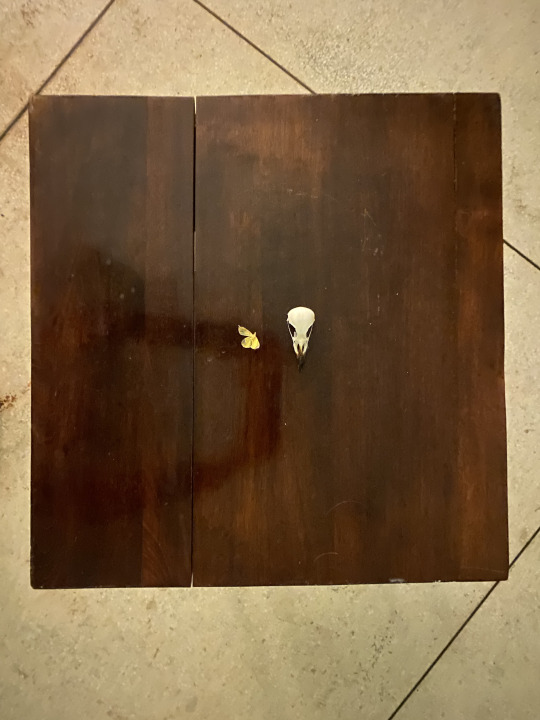


I first heard of this opportunity through Paul Hillon. Paul emailed me the day before the deadline for the expression of interest form needed to be sent in so I made a quick decision about which work I would include in the form, keeping it quite broad with a view that I would be able to make a few changes later on if necessary. Carol Jobling, who was the main contact at Poltimore, was very keen to have me involved with the show and offered me the opportunity to take over an entire room (the Old Operating Theatre) to form a sculptural installation. I went to visit the site a few weeks before the exhibition so that I was able to start loosely planning the layout of the works. I was astonished and so excited about the space as I didn't realise how well preserved it was. With my increasing interest in the function of the ruined site within my work and the flexibility of the opportunity, it felt like a dream come true!
My initial visit to the space was very rich and once again it fed into my primary/visual research into the key signifiers of abandoned spaces. The image below demonstrates a very clear visual similarity to my ‘unearthed encounters’ final installation through the peeled away wallpaper and stripped back flooring. During the visit, my dad said that it reminded him a lot of my work and that he could really see how I had formulated the visual representation of an abandoned space within the installation.

As I didn't have much time to prepare new work due to only finding out about the opportunity so close to the deadline, I will be in a much better position next year to spend time making work in direct response to the site. I have managed to locate a few research sources that I will continue to engage with. I did conduct some research into the Old Operating Theatre prior to the set up of my exhibition. I found that "in the summer of 1945 the house was bought by two Exeter doctors who recognised the urgent need for new hospital bed spaces, and for a maternity hospital to cope with the post-war baby boom" (Poltimore.org, 2021). I also found a photograph on their website which shows an operation being carried out (see below). The photograph is undated, however from looking at the other photographs with captions it appears that it might have been taken in 1958.
After visiting the site, I started thinking about how I was going to engage with the space. I felt it was important for my work to accompany the relics that were already situated in the room, particularly as it is so well preserved. I thought about the extensive history of the house and the atmospheric nature of the Old Operating Theatre. I imagined all of the lives that could have been lost, or almost lost, there and how that room in particular was symbolic of human frailty and the body in pain. This notion tied in greatly with many of my material explorations from over the past year, including 'backbone' (2020), 'remember me' (2020) and 'scar tissue' (2021). I thought that this installation would provide me with a great opportunity to experiment with already existing work in order that it may be recontextualised through the history of the site. I have also recently started working with audio so I also starting thinking about how I could incorporate a sound element to make the installation more immersive. This opportunity gave me the chance to take aspects of my 303 work into a new environment, forcing me to test the narratives. One specific decision I made as part of this opportunity was to position the baby shoe cast in front of my ‘scar tissue’ sculpture to invoke the possible absence of a child (see below). Juxtaposed with the skin-like ‘remember me’ sculpture, this brought a new realm of possibility to the work.
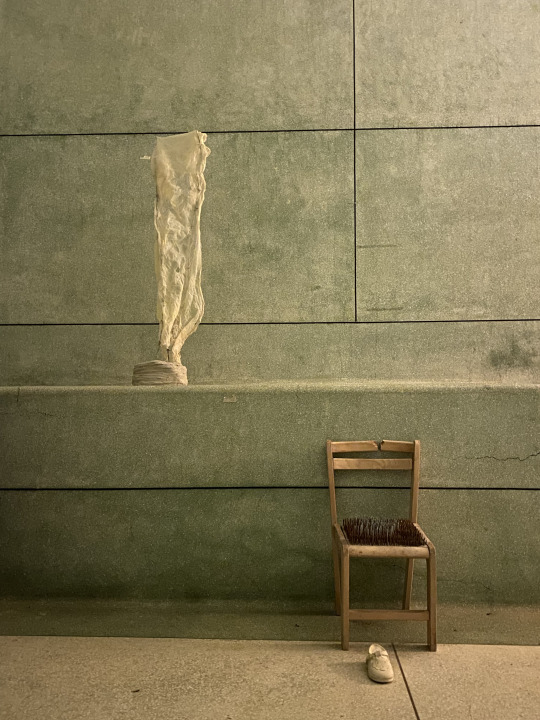
The initial part of installing the work involved removing unwanted tables and other items that were placed in the room for storage. I then began experimenting with different layouts for my sculptures and objects in relation to the space and the objects that already inhabited it.
Statement for the work (written for my online portfolio):
Site-specific sculptural installation with audio (1:41 mins) featuring the following sculptures & objects: 'scar tissue' (2021) - child's fractured wooden chair, nails; 'sanctuary II' (2021) - bird cage, concrete; 'ghost' (2021) - cellular blanket, concrete; 'remember me' - latex, barbed wire, clay; 'backbone' (2020) - wax cast with pigment; jesmonite cast baby shoe & fragmented teddy bear from 'unearthed encounters' (2021) installation; mirror, oak table, magpie skull, dried butterfly, dried flowers.
A sculptural installation created in response to the preserved Old Operating Theatre at Poltimore House, Exeter, uk. Existing work was recontextualised through a process of experimental curation and engagement with the space. Through research it was discovered that Poltimore House was repurposed as a hospital in the summer of 1945, during which time the Operating Theatre was built on the grounds. Works which were chosen to be featured within this installation emphasised the experience of the fragile human body in pain, with thoughts about the many lives which would have teetered on the edge within this space heavily influencing the final presentation of the work. (Smith, 2021)
References:
Poltimore.org. (2021). [Online]. Available at https://poltimore.org/poltimore-hospital/. [Accessed on 11/08/2021]
Smith, L. (2021) Creative & Professional Folder: Live Project: untitled Site-Specific Installation for ‘Poltimore Art 2021′. p. 32.
1 note
·
View note
Text
** CAMP Artist Talk: Phoebe Boswell 18/02/21
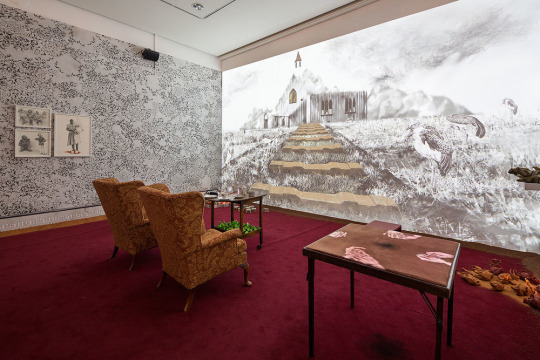
Phoebe Boswell, The Matter of Memory, 2014
Talk Notes
https://www.phoebeboswell.com/
A tutor told her - “You make work to fill a hole, the difficulty is trying to figure out what that hole is.”
Care as antidote, the future as hope.
We are memory and earth and freedom and hope.
We are speculative and nuanced.
Art making as ritual practice, liberal practice, a safety valve.
‘Acadia’ - a discontinued term - a man seized by this emotion who is disgusted. Coined by a monk
How we see each other / how we fail to see each other.
Multidisciplinary artist
Part of CAMP’s series relating to resilience and care.
Zanzibar - where her parents live - charcoal and paint drawings of fisherman - their fishing livelihoods are now heavily affected by tourism, over fishing and climate change. These fisherman were descendants of slaves.
“How will you practice freedom today?”
Rights, representation, labour, activism, precarity. Not intrinsic to life, something that can be taken away, perverted.
Work:
Cluster - Eye, Rapture/Rupture, A Broken Heart, New Moon. Looped video projections, Medical imaging, 2018.
Ythlaf, looped video, 2018.
Transit Terminal, charcoal and carbon on constructed box plinths, 2014.
The Eye series, pencil on paper, 2018.
Performative | Black | Square, instagram posts, June 2 2020.
There is Peace There, charcoal and pastel on paper (diptych with cutouts), 2018.
For There Is Softness There, charcoal and pastel on paper, 2018.
And I Can Cry There, 2018.
And We Can Laugh…, 2018.
Untitled (from Take Me to the Lighthouse), 2018.
Matatizo, 2015.
The Matter of Memory, installation, 2014 - recreated her grandmother’s living room and filled it with narratives that explore familial love and the trauma entrenched in history. Born in Kenya. Born as a result of an urge to go home but didn’t know what home was. Neither Kenya or England. Did have her parent’s memories of home. Recorded both parents talking about their childhood. Unliniearity of human existence. Made small drawings, tiny animations and sculptures in response to these recounting. Each chair has each of the parents speaking with her speaking over the top repeating their words, taking ownership of the stories.
We care for the stories that we tell.
Importance and profoundness of stories that define our existence.
Medium, how we tell stories and how things can be reinterpreted. Intimacy and scale. You can only see certain projections from certain places in the installation, e.g. from sitting in the chair with her father’s voice.
Always a wound and a projection of animated flies onto the wound.
Made drawings based on family photographs of new formations of family members that had never met. Rewriting and remaking memories, right things that were wrong. Using work as a process of healing.
Mutumia (working drawings), 2016. An ode to women who have used their bodies as a form of protest. Used real women as models for the drawings. Shame, sisterhoods, resilience. 30 minute looped animation - took 9 months to make. Pencil and paper animations. Inside the floor was a series of hidden sensors that triggered different sound tracks. This work featured in the Venice Biennale. People were encouraged to draw and write with charcoal in the installation. It became a chaotic work which changed completely as a result of the interaction by the audience.
‘Food for the spirits’ - What does it mean to stand in your own body as an author of yourself? Based from Adrian Piper’s self-portrait series when he isolated herself over a period of time and documented it.
Who are we and how do we give ourselves agency?
Had a significant trauma where she lost the sight in her eye and had a mini heart attack. Made work as a result collaborating with another artist, self-indulgent work which was healing in a wider context. Everyday she would photograph herself in the morning however she was feeling and that would be the drawing of the day. She drew these in a gallery space everyday over a period of 3 weeks. Drawn in soft willow charcoal - wanted it to be as fragile as she felt. Notions of trust interwoven. Cathartic experience where she had to see herself in all moods. Kept having memories back to a photograph of her when she was child so started drawing her as a child in order to engage in dialogue with her younger self. Made her realise what art can be and what it can do in relation to trauma.
Received the British School at Rome residency at the Slade School of Art (2019). Working in a space that was built on colonialism, she started examining what it means to make black work in white spaces. How to speak truthfully about black experience. Contemplated instead what whiteness was, how it functions, what it was afraid of and why it was afraid. Thought about how whiteness permeates archives and history. Got quite bored quickly of drawing the white, male body. Learnt of 3 black male deaths that had been reported in Italy, created work in response to how they were reported by in Italian press. The drawings change depending on how they are viewed/engaged with (i.e. light, colour). Three drawings: I See You / I.C.U [Rest in Power, Pateh Sabally], 2019; Wake Work I / Chiuere, You Are Loved / Wake Work II [Rest in Power, Emmanuel Chidi Namdi], 2019; Sing, Beloveds, Scream, Be Loud, Remembert, We Were Never Meant to Survive [Rest in Power, Idy Diene], 2019 - Took flower pots from the fountain where Idy was shot and smashed them in the gallery space.
What happens when you perform erasure? Abstraction through colour and tone; sometimes the work was not visible at all depending on the light and it was only a black square that appeared visible.
PLATFORM, moving image public work in situ at Lancy Bachet Railway Station, Geneva, 2020. I AM - every time someone disappears, their sentence appears and lingers beyond when they sentence disappears.
Thinking about the sacred bond between the artist and subject. The eco system of care, how often careless the art world can be, how we cope with the way in which art feeds into capitalism.
Question: What are we willing to lose?
Q&A:
She grew up naive about the systems and structures in place in terms of race and gender. She didn’t know how she would be perceived in England until she got here.
Belief systems - why do we believe things? The spirit world? What makes us believe this?
Navigating the middle space is sometimes difficult.
Reflection:
This was a truly inspiring and lovely artist talk. I resonated with Phoebe Boswell's work so much and found the way in which she presented her work and the talk itself incredibly poetic. Boswell's drawing talents are truly phenomenal and her ability to translate her practice through different mediums is brilliant. This was my first CAMP artist talk and I am so glad that I attended. The opportunity to ask questions at the end helped make the talk even more personalised. I was particularly interested in her installation work 'The Matter of Memory' (2014) as it resonated with me greatly in the context of my degree show practical project due to the similarities between mine and the Boswell's need to explore identity through the exploration and recounting of personal histories. There was an opportunity to enter a competition to win a tutorial and portfolio review with one of the CAMP visiting artists, Phoebe Boswell being one of them. Unfortunately my name wasn't drawn out of the hat, however I do feel that the talk itself was thorough enough for me to have learned enough about the installation itself and the level of detail that went into creating it. Boswell truly thought of everything, from tiny animations in teacups, to replicating her grandmother's living room. This was my favourite artist talk to date. (Smith, 2021)
References:
Boswell, P., (2014). The Matter of Memory. [Online]. Available at https://www.phoebeboswell.com/the-matter-of-memory. [Accessed on 05/03/2021].
Smith, L. (2021). Creating and Professional Development Folder: CAMP Artist Talk: Phoebe Boswell. p.132.
0 notes
Text
**Artist Statement for my final installation ‘unearthed encounters’
Artist statement for the Degree Show:
Lucie Smith’s practice seeks to grasp the present whereabouts of her being through critical consideration of her experience of the world. By exploring the expansive realm of art process and medium, she attempts to unite past with present and unconscious with conscious. Notions of memory, trace, absence, separation and home are interwoven; alluding to a collective fluidity of the passage of time.
Autobiographical and sometimes confessional, her practice is rooted within the concealed, allowing a process of analysing the internal to take the lead in obtaining narratives. Amongst fascination with the function of site and place within her practice, Smith is also driven by the philosophical and psychoanalytical theories that underpin her ideas and practice, often utilising symbolic contexts in order to entwine thought, theory and material.
About the work:
wallpaper, wooden floorboards, oak table, glass, jesmonite, family relic objects, porcelain, framed photograph, broken ceramic sink, bricks, rotten wood, rubble, sand, ruderal plants, broken bird nest, old comb, fragmented audio (5:55 mins)
‘unearthed encounters’ embodies the experience of memory and place through a process of materialising the uncanny. The work brings together fragmented verbal recollections from within the artist’s family alongside the remains of sentimental objects, some cast and fractured, others in their primary form. It explores the frustration of the unspoken and the continuous process of both reuniting and dissociating with past memory; an in between space of remembering and forgetting.
0 notes
Text
**Evaluation & Critical Reflection of the Module
The work I have made for this project is probably my favourite to date. I feel proud of the amount of work and research I managed to achieve across the module, as well as of course the quality of the work I have made. Since the start of the project and beyond, I have gained invaluable skills and made wonderful connections with other artists. It was certainly a struggle at times having so much on at once, particularly with the Project Space One show and the 301 module deadline all happening alongside my developing work for this project. It hasn’t always been an enjoyable process and it took me a while to feel happy with my final output due to the amount of work it took to make it. However, I am glad that I can now express content with my final output.
I have a tendency to give myself a lot to do which means that I am not always equipped to deal with the plans that I have. I am fully aware of this and it seems that no matter how much I organise and plan my time, situations can and do crop up when I least expect them. A key example from this project was when my glass display case broke a few days before the exhibition set up deadline. I had built the original glass display case a few months before the deadline, however hadn’t realised how difficult the sandblasting aspect would be which was vital to the final finish of the box. This is what resulted in the box breaking. Luckily, I had a few days to fix it and Amy from Glass was on hand to help as it was the week after the official deadline. This scenario proves that no matter how early some tasks are completed, when it involves new material territory, there is always a risk of things going wrong. This last minute problem ended up encroaching on my exhibition set up time. As a result, I had to come in early on the Monday before the exhibition opened to complete finishing touches. Thankfully, a few people from the class, as well as, Paul and Sarah came to help me with my install on the Friday; without which I definitely wouldn’t have got everything finished. I hadn’t planned for any assistance and this taught me a valuable lesson about asking for help when people are able to give it - something which I really struggle with.
In relation to my Project Proposal, I feel I have successfully achieved my intentions for my concept and research plans. I continue to make headway with the books listed in the proposal and am always on the look out for more written material to enhance both my understanding and the development of my practice. I did end up spending more money than intended due to having to purchase speakers and extended audio jack leads because the speakers that Paul had in the Fine Art store were too quiet. I found that the sound aspect of the work was a challenge as I tried to ensure that the audio was legible for people to feel invited into the space whilst also not being too loud. I wanted there to be a sense of intimacy but also boldness to the work. Finding the right volume, whilst also ensuring that other invigilators were able to set the right volume was a challenge. On reflection, I probably would have spent more time experimenting with sound level and stipulating the exact level on the instruction form. The sound level changed a lot depending how many people were in Studio 11 at once, which was another factor that affected the work. This was my first time working with audio and I was ambitious to have three separate channels running at once. Although there were many hiccups during planning and set up, I feel I learned a lot from the process.
A great success for me as a result of this project was having my work featured on the Plymouth College of Art website as a graduate work of note, along with a feature on the a-n (The Artist Information Company)’s website as a highlighted graduate. I was later picked by a-n as one out of seven highlighted graduating artists out of the whole country on their Instagram page which I felt really proud of.
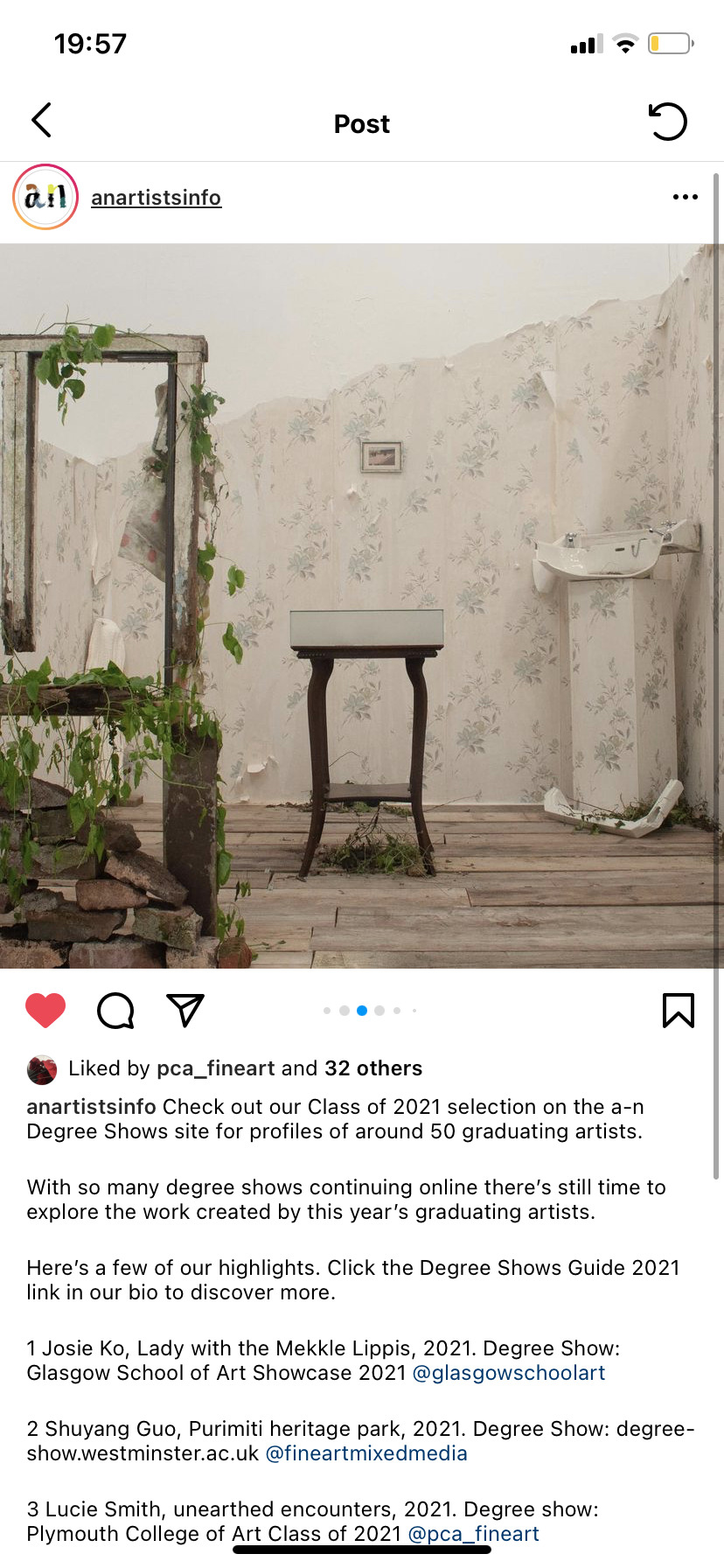
Reflecting on my work since year one of my degree whilst writing up my journals for my professional practice and this module, I can see a very clear link between all of my thoughts, ideas and works. It has been an incredible journey of discovering corners of contemporary art, philosophy, psychoanalysis, literature and so much more that I could never have imagined before starting my degree. I am so thankful for the guidance I have received and am excited to see what the future holds.
References:
a-n The Artists Information Co on Instagram: ‘Check out our Class of 2021 selection on the a-n Degree Shows site for profiles of around 50 graduating artists. With so many degree shows…’ (2021). [Instagram photo]. Available at https://www.instagram.com/p/CSEr9ZlMI4o/. [Accessed on 17/08/2021].
0 notes
Video
A video of me mixing and pouring the silicone for the molds...
0 notes
Text
** The Book of Symbols by Ronnberg & Martin: Symbolisms within the Final Installation
Page 526 - Comb: Comb has its name from the Indo-European ghombos, or “tooth”, and the comb’s teeth have long been associated with the light-giving, spermatic energies of the sun and sunlike consciousness.
The comb’s relation to earth’s fertility extends to the timeless and sensual image of a woman combing her hair or having it combed by a lover or maid - participating the eros of unknotting, disentangling, smoothing, caressing and bringing light to the deep-rooted mysteries of psyche and nature.
Even in the hair, the comb can, if the combing is a rough, impatient ordering of the head, cause tangling where it would normally sort out. Likewise, if the comb of conscious discrimination is forced to serve a too critical, compulsive investment in making things neat, creative ideas may get hopelessly snarled.
We must die to become
true human beings.
We must turn completely upsidedown
like a comb in the top
of a beautiful woman’s hair.
Rumi, Say I Am You
Page 542 - Necklace: Protection, courage, love and life itself. The breaking of a necklace might suggest that a relationship to someone or something needs to be broken; or perhaps it is a warning about a loss of order, protection or something of great value.
Page 546 - Ring: Symbolise bonding, binding, promises, vows, covenants.
Page 550 - Shoe: Signify ‘a casting off of worldliness’, absence of a person who once inhabited them. In my case absence of a past self.
Page 584 - Table: A medium for animated life, gathered company and relationships, whether harmony or discord. It is the potent object of delimiting, joining and setting apart at every kind of corporate meeting.
Glass:
Translucence, transparency, refraction. Conveys beauty, ornamentation, purity, delicacy and extraordinary fragility.
Crack:
Can be an opening into the world of imagination, while the crack in a teacup make it a leaky container, no longer safe. Cracks evoke dryness- the dry lips of fever or a house no longer cared for. Our voice cracks in a moment of insecurity, whilst the splitting experience of mental illness is often felt as if one’s whole world is breaking apart. Leonard Cohen: “There is a crack in everything / that is how the light gets in”. When something falls between the cracks it is forgotten or lost.
Between what I see and what I say,
Between what I say and what I keep silent,
Between what I keep silent and what I dream,
Between what I dream and what I forget:
Poetry
- Octavio Paz
References:
Ronnberg, A., and Martin, K., (2010). The book of symbols. Taschen Cologne. Available at https://aras.org/sites/default/files/docs/00040Ronnberg.pdf.
0 notes
Photo

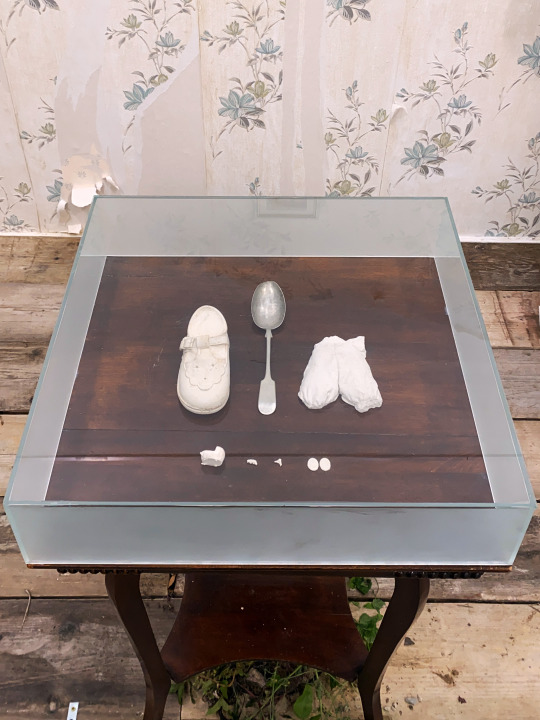
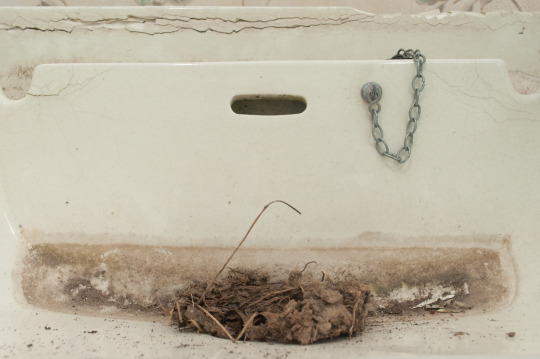
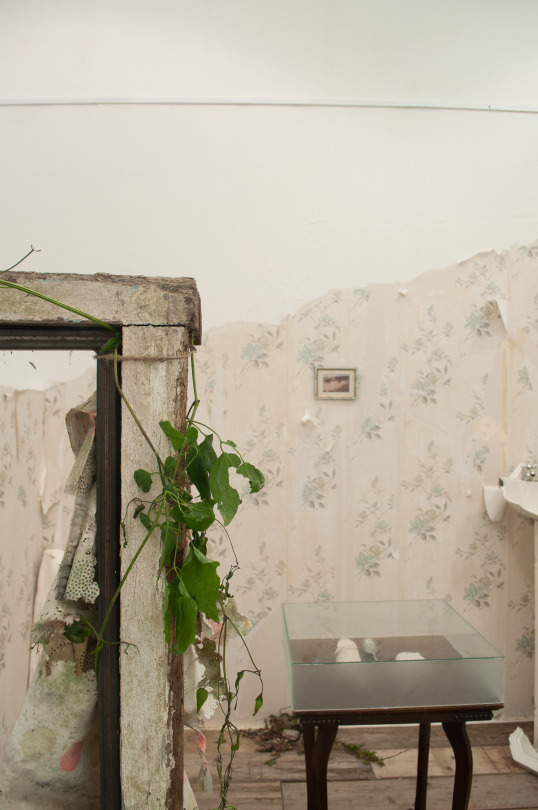





After much deliberation, Paul and I decided it would be a good idea to use an upside down plinth to hold the sink up as I had originally planned to attach it to the wall using a bracket however due to how brittle the sink is, this wasn’t a good idea. I feel that this worked really well in the circumstances, especially as I wallpapered it. I added the comb and nest from the cottage at the end as I felt it added some little extra details to the work.
My personal symbolisms within the work are:
Broken sink - the domestic definition of home as ruptured; The sink captures the idea of how feelings are retained, and turned on and off, since water generally symbolises emotions. The sink itself, is usually where we wash or remove unnecessary residue as a symbol of washing away difficulty or outworn ideas.
Cracks in the sink - Cracks evoke dryness- the dry lips of fever or a house no longer cared for. Our voice cracks in a moment of insecurity, whilst the splitting experience of mental illness is often felt as if one’s whole world is breaking apart.
Broken birds nest - sanctuary destroyed, unhomeliness
Comb - self, untangling, unpleasant feelings while someone else combs your hair - I have many memories of this as a child
Table - a pedestal and a piece of furniture designed for holding objects. A medium for animated life, gathered company and relationships, whether harmony or discord.
Dressing gown - the absence and trace of my childhood. I purposely chose an aged 10-11 dressing gown to represent the age I was when I first became aware of my surroundings as a child
Glass box partially frosted - Obscuring the personified objects from certain angles. You are unable to see into the box whilst stood outside of the installation, only when you step into it. Translucence, transparency, refraction. Conveys beauty, ornamentation, purity, delicacy and extraordinary fragility.
Ruderal plants - disorder, instability, neglect. The act of leaving them to slowly shrivel and die encourages these symbols.
Soil - nature’s inevitable reclamation of an abandoned space, life and death
Spoon - family relic that has been passed down through the family
Cast fragment objects - remains, liminality
Sound - spoken word fragments of the mundane and the intimate, juxtaposing the said and the unsaid, frustration
Layered wallpaper - peeling away of memory, replicating a neglected and left behind home
Bug bitten wooden floor & rubble - replica and similarity to the cottage
Framed photograph - centralising the viewer’s gaze to a symbolic visual context of past memory. A visual fragment of family history & juxtaposition of showing a seemingly normal family home.
For safety reasons, we had an invigilator sit by the exhibition at all times to ensure that people didn’t touch anything they shouldn’t and to supervise them as there were some sharp edges. Paul also advised me to stick the bricks together. I used silicone for this which worked well. It was interesting to see how people engaged with the installation during the exhibition. Some people walked straight in whereas others were reluctant and looked for permission to enter. The floorboards wobbled slightly which I think added to the immersive, uncanny atmosphere a lot and this made people tread carefully around the space. Being on hand to watch how people interacted with the work was a real treat. I was told be quite a few people that they found the work really brave and moving, which was lovely feedback to receive. The most interesting feedback I received was from Phil’s friend who is blind. Phil and I assisted her in the space and allowed her to feel some of the surfaces whilst she listened to the audio. We then spent time describing some of the aspects of the exhibition. She said that it felt really nostalgic for her and reminded her of her own family. She also said that it made her think of hierarchy within families and that it really resonated with her experience of the 20th century generation in that important events within families are not spoken about resulting in festering emotions and delayed feelings coming up later on in life. It was amazing to hear her feedback simply through sensory engagement as she understood my work and concept so well.
1 note
·
View note
Photo



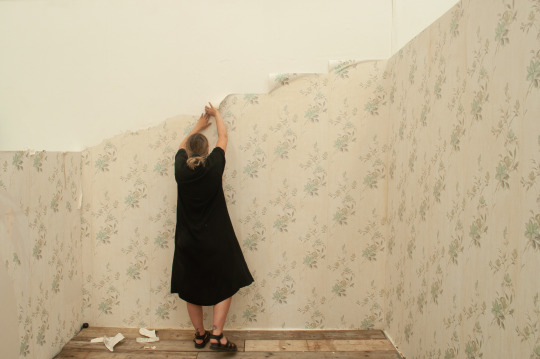




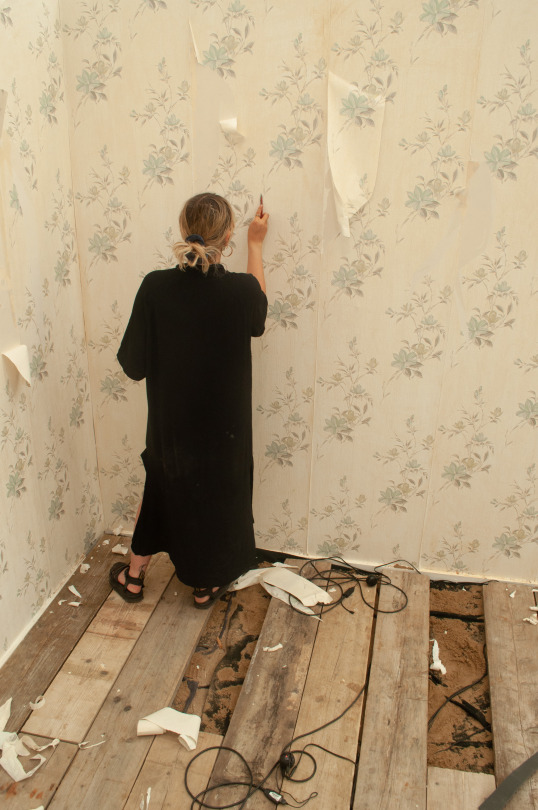

Setting up the wallpaper after tea-staining it. I used a scalpel to help me rip my wallpaper to reveal the under layer of wallpaper. On reflection, I wish I hadn’t stuck the wallpaper so well to the under layer as it made it quite difficult to rip. That said, I think it still looked great.
303 set up plan
Monday:
Wallpapering + wallpaper plinth
Fablab plastic sheet for sandblasting
Flooring
Rebar stand with Noah
Tuesday:
Teaching personnel interview - 11am
12-1:30 -
Wilko - command strips
Jesmonite
Sandblasting
Wednesday:
AM:
Take car in to get plinth
Jesmonite + sandblasting
PM:
Finish wallpaper
Flooring
Half rip wallpaper one left wall
Thursday until 3pm:
Set up window, brick wall, plinth with sink
Set up speakers and test audio / reedit volume on logic / audition
Print photo
Friday from 2pm:
Bring in dug up plants
Finishing touches as needed
Rip other wallpaper
Photos
0 notes
Link
Planning and setting up for the final installation exhibition...

I managed to find an aged table on marketplace that would fit my glass display case on it as a pedestal for presenting my cast objects.

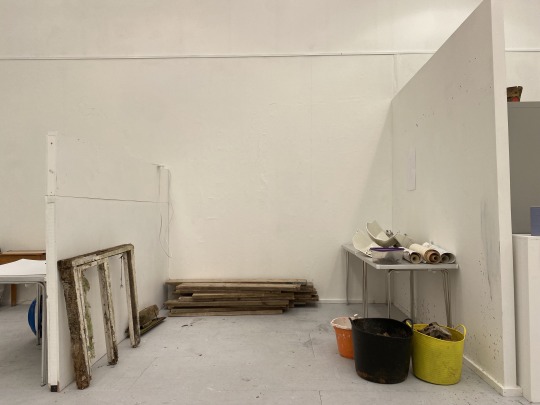
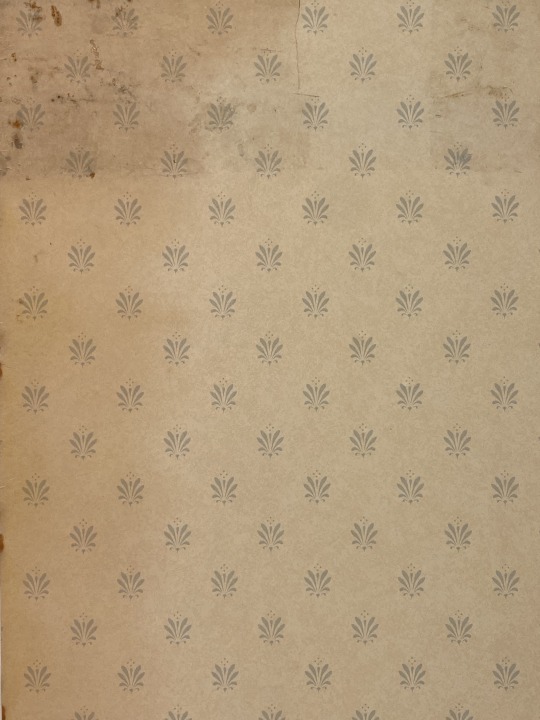

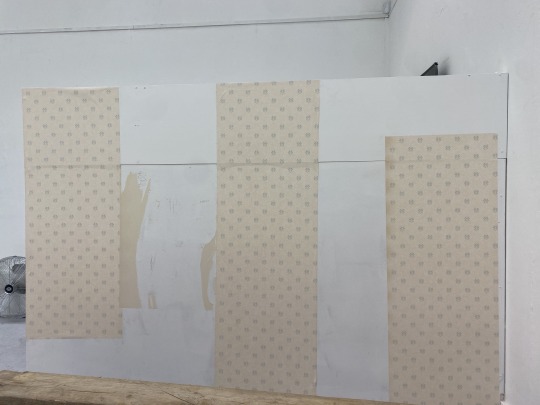





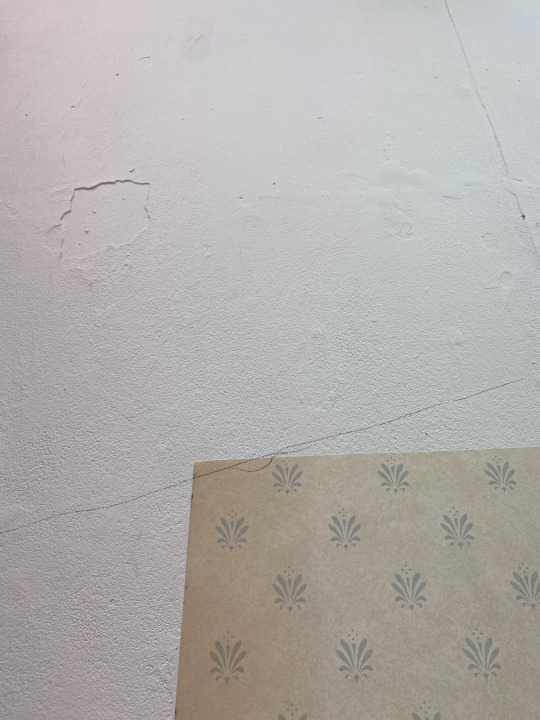
0 notes
Text
** 37 Looe Street: Episodes in two Flats and an Office at PAW 2020
Revisiting my professional practice write ups reminded me of this work at the Plymouth Art Weekender 2020. It largely fed into my interest in the archive and I was particularly drawn to the fragments of wallpaper and the letter that they discovered. It was amazing to see the amount of objects that they recovered from inside the building during their renovations. These tiny tokens of history were really pivotal to my thoughts about the about the role of the fragmented object in relation to architecture, site and dwelling. They were so subtly displayed yet so rich in history through detail. I ended up having a great conversation with one of the new owners of 37 Looe Street whilst there about the history of the building and objects, which shows that they are a great starting point for thought provoking conversations to start.

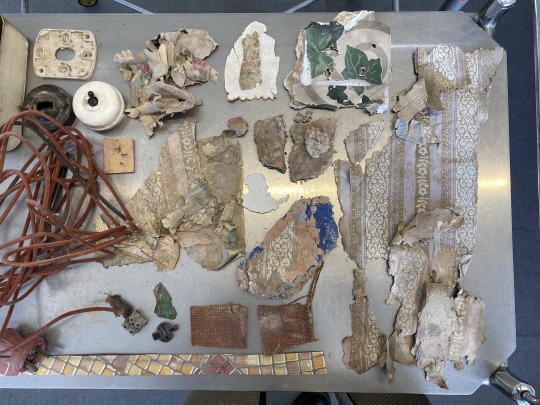




0 notes
Text
**TRACE Liverpool Biennial (1999) Catalogue
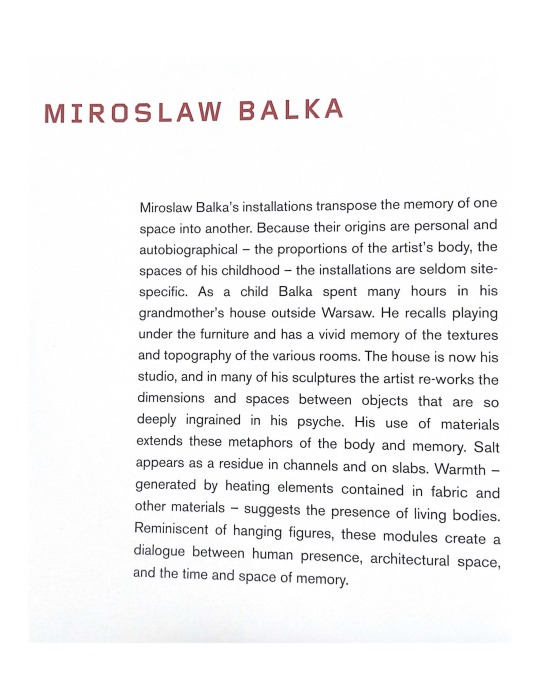




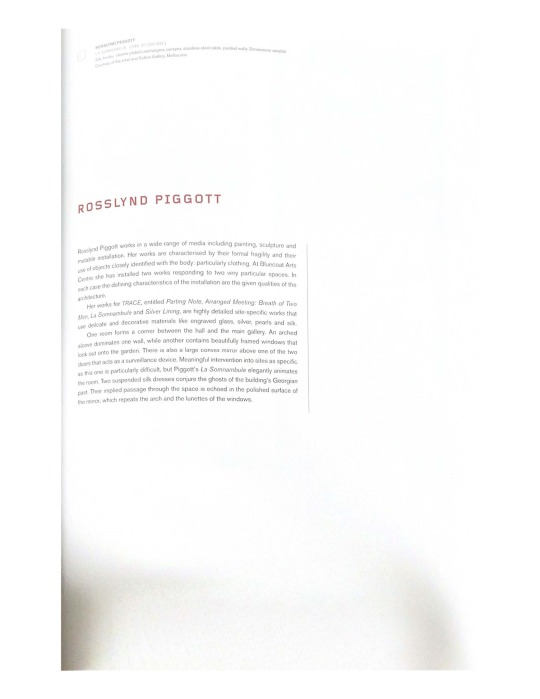

A Historical Contextualisation of Theme by Anthony Bond
Page 12’ - By incorporating the traces of people, events or natural forces, artists are able to maintain an open text, so to speak, so that the work is recreated anew by each viewer, and in each act of viewing. In this way trace connects the internal and external worlds of artist, viewer and object, allowing the work to operate in the present, while also functioning as a sign of past or absent referents.’
Page 14 - Picasso and Duchamp were two pivotal figures in the introduction of conceptual art. ‘Both artists experimented with reintroducing objects and materials as signifiers. This was to become a crucial strategy for opening up the boundary between art and life.
Page 16 - ‘Conventional accounts of representation always present it as a substitution of one thing for another. A symbol stands for an object; a narrative scene for an event in the real world. The effect of these substitutions is a closed system of signification that, by virtue of its completeness, excludes both the experience of the real, and the memories or associations of the viewer. The strategies adopted by artists in TRACE invite the participation of the viewer by transgressing this logic of substitution.’
‘It is possible to chart the reintroduction of the material trace from Picasso’s Still Life With Chair Caning in 1912 and Duchamp’s introduction of the Readymade in the same year, through the evocative assemblages of Joseph Beuys, to a proliferation of found objects in contemporary art.’
Page 19 - ‘In public performances, Joseph Beuys used his body heat and actions to manipulate materials. By biting pieces of fat, for example, he left the imprint of his body on the objects themselves. Some of the photographs taken documenting these performances are shown in the TRACE exhibition. The traditional silver gelatine process was used to print these images, with the printing emphasising the chemical trace of light that makes photographs such a powerful index of a moment in time. This process - by which the energy of light is transformed into silver salt - is itself a metaphor for Beuys’ theory of sculpture as energy transformed into form. These are not simply documents. They are material residences: relics of an ephemeral reality.’
Page 20 - ‘Photography as trace is a thing in itself. On on hand, the photographic image seems to offer an objective record of events; on the other, the photographic print can be seen as an object or process in its own right.’
‘This is photography as a physical trace of the past. When the camera’s shutter opens, light travels from the object to the film where it causes a chemical change to the silver nitrate. This, in turn, leaves a permanent record of the passage of light, and a shadow (the image) of the object. Because the resulting print is literally a material trace of the object, it can function like a relic.’ - Links to my thoughts and ideas from 202 and into 301 of the relationship between trace, presence, absence and positive/negative entities.
Page 20 - ‘When we take a photo of a lost love from a box or forgotten drawer, the shock is not just of visual remembrance: it is doubly disturbing because it seems to be a trace of that person, like finding a strand of their hair.’
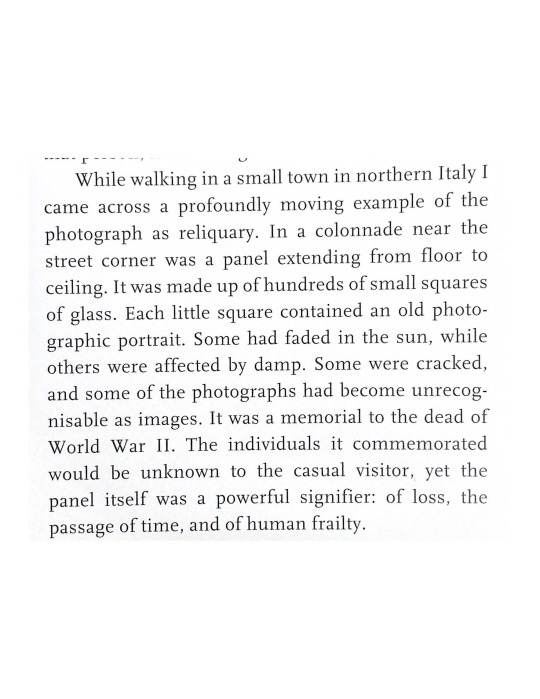
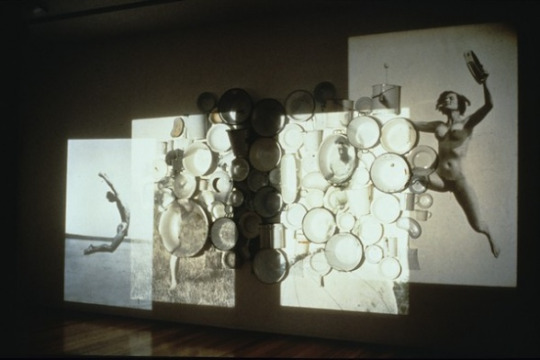
‘Alex Rizkalla collects photographs and other objects that are historically specific, yet have the capacity to exceed their original significance and function. Rizkalla’s collections occupy the line between archive and Wunderkammer. He uses his objects to tell historical narratives, while allowing their material qualities to generate a range of associations and emotional responses.
Page 21 - ‘Through these collections of objects, people were able to tell their own stories and create a personal space. Together with texts - often quoting the artist’s collaborators - the photographs were assembled into graphic structures.’
A Lasting Impression by Charles Merewether - Page 164
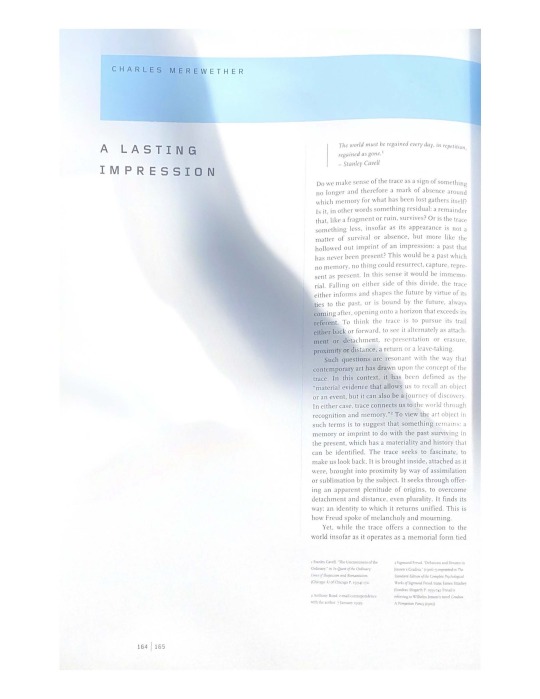

Page 165 - ‘While the trace offers a connection to the world insofar as it operates as a memorial form tied to the past, it is governed by the structural possibility of its iteration or repetition, which is itself only possible by virtue of the absence of the repeated. It is retroactive, subject to a certain departure, to a leaving behind in order for memory to be produced, and therefore opens itself to a future because it remains to be seen - can only be seen - and therefore understood, after the fact.’
‘The trace becomes a past that has never been present, that is always under the sign - if it can be called a sign - of erasure.’
Freud’s - ‘Delusions and Dreams in Jensen’s Gradiva’ - ‘For Freud, Jensen’s story concerns the idea of the past being in some way still present, as though locked up inside the present. Archaeology could provide a way of thinking through the very concept of memory and the unconscious, and art - like writing, like the archive - represented a prosthetic aid to memory.’
Page 166 - ‘There is an internal division in Freud’s account between the primacy of psychic apparatus, and memory as prosthetic or auxiliary representation. This division enables Freud to imagine the possibility of recovering the moment prior to the separation or ‘abandonment’ of the imprint from the impression.’
The trace and the archive. The trace exceeds both its origins and the archive.
Page 167 - Traces were not simply signs and clues, but the residual remains, the material evidence, the stuff of history.’
‘Seen within the present, art represents the survival and transmission of the past, carrying with it traces of another place, time and culture.’
The artwork in itself is a trace.
‘The footprint then becomes the mark of absence, the loss of origin, and possibility also of return to anything other than the trace.’
‘The trace is founded within a movement of erasure: an erasure because it is only a shadow or imprint of the impression made in the sand.’
‘Presence becomes the sign of an absent origin that has never been present, but is always a past to come. That is, a presence that in being predicated on absence, exists only by virtue of coming after, by way of repetition. Materiality is not simply a given that bears traces, but rather is itself defined, shaped and stabilised through processes of selection, exclusion and elaboration. The materiality that the trace assumes is then witness to the fracture of its own condition. The trace neither reaches back nor carries forward, as if bound by and to the referent. It is not a sign insofar as it is purely indicative or stands in an empirical relation to an event or something once present. There is nothing residual here - no fragments, ruins, marks or evidence - so it does not seek (by way of pathos or nostalgia) an originating moment.
Page 168 - ‘We might say that the work appears to gather its meaning by way of an estranged relation to itself. By neither repeating or returning us to the place of origin, the index opens up an interval that is discontinuous with what has gone before. This is not a work of nostalgia, a re/turning in the sand as if symbolising an experience of loss and desire to recapture the past or an identity of self through an origin. Rather it marks a space between impression and imprint, neither present nor absent insofar as there is no plenitude either given or referred to as elsewhere.’
“The opening of the empty is not only the sign of an absence. The figure traced on the sand is not the element of a path but the very emptiness of the past. And that which has been withdrawn is not evoked, does not return to presence - not even to an indicated presence.” - Emmanuel Levinas
The Trace and the Body by Susan Best:
Page 172:
“Things have an internal equivalent in me; they arouse in me a carnal formula of their presence.” – Maurice Merleau-Ponty
“Trace is more usually thought of as an indexical sign of an object: the footprint, the fingerprint, more distantly perhaps, the photograph, described so eloquently by Susan Sontag as “something directly stenciled off the real.””
“The result of the outer world touching some impressionable surface and leaving a legible mark.”
“Some traces, though not clearly visible, are nonetheless sensed. Like memories they are insubstantial or imperceptible markings, and yet they are able to insinuate themselves into the present through some unseen subterranean route.”
Page 174:
Merleau-Ponty’s conception of the trace: “Something experienced by the body that can be externalised by the artist, an ‘inner form’ that is the result of a complex interlacing of body and world.” – Merleau-Ponty, M., (1968). The Visible and the Invisible. pp.130-55
“The trace, then, is something like a hinge between inner and outer experience: it is not simply an attribute of objects; nor is it an impression sealed up in the human subject. Rather, the trace is the play between subject and object, or more properly, the “intertwining” of the two.”
“Things, then, are no ‘re-presented’ internally. It is their presence that is felt, or rather their presence is aroused in the beholder, as once again, things already have some kind of nascent existence in the body.”
“We can accept fairly readily that traces are echoes of things, or even transmutations of them – ashes, dust to dust, there are many such fundamental changes in substance that bear witness to a thing’s life cycle.”
“There is a complex weave of traces linking body and world.”
A cavity has become solid, a volume has become a mass, space no longer contains objects, it is rendered as an impenetrable object.”
Page 174:
“We have the profoundly disturbing sense of ourselves as cavities, containers with an interior space that could be inverted.”
“What we recognise, or find awakened, is our internalised spatial practices.”
“Its bleak environs comes instead from the very unsentimental recognition that the past has made possible our horribly disjointed present.”
References:
Bond, A., (1999). Trace: 1st Liverpool Biennial of International Contemporary Art; 24 september-7 november. Available at https://ixtheo.de/Record/1609394887.
0 notes
Text
**Theory Research: Gaston Bachelard ‘The Poetics of Space’
Chapter 2 - House and Universe
Page 59 - When dreams and memories come together, an essence of fluid like recollection comes into play and we become almost dissolved in this fluid of the past.
Sometimes dreams go back so far into an undefined and dateless past that clear memories appear to become detached from us. Our past is situated elsewhere, with vast time and place passing by causing a state of unreality.
“Have facts really the value that memory gives them?”
We hover between the awareness of being and the loss of being.
It is possible for imagination, memory and perception to exchange functions. An image can be created through the balance between the real and unreal. Dreams of memory and memory images can become something that stands between the imagination and the real; proving that it is not always the true recounting of such a memory that is important, it is the personal perception and meaning to the individual that matters.
Page 67 - ‘And so, faced with the bestial hostility of the storm and the hurricane, the house’s virtues of protection and resistance are transposed into human virtues. The house acquires the physical and moral energy of a human body. It braces itself to receive the downpour, it girds its loins.’
Page 77-78 - ‘If we have retained an element of dream in our memories if we have gone beyond merely assembling exact recollections, bit by bit the house that was lost in the mists of time will appear from out of the shadow. We do nothing to reorganise it; with intimacy it recovers its entity, in the mellowness and imprecision of memories and we ourselves were dissolved in this fluid of the past. Rilke, who experienced this intimacy of fusion, speaks of the fusion of being with the lost house: “I never saw this strange dwelling again. Indeed, as I see it now, the way it appeared to my child’s eye, it is not a building, but is quite dissolved and distributed inside me: here one room, there another, and here as a bit of corridor which, however, does not connect the two rooms, but is conserved in me in fragmentary form. Thus the whole thing is scattered about inside me, the rooms, the stairs that descended with such ceremonious slowness, others, narrow cages that mounted in a spiral movement, in the darkness of which we advanced like the blood in our veins.” - Rainer Rilke, Vergers, XLI.
Page 78 - ‘Our past is situated elsewhere, and both time and place are impregnated with a sense of unreality. It is as though we sojourned in a limbo of being. Here, for instance, is a page of concrete metaphysics which by overlaying our memory of the childhood house with daydreams leads is to the ill-defined, vaguely located areas of being where we are seized with astonishment at being.’
Chapter 4 - Nests
Page 112 - ‘Already in the world of inanimate objects, extraordinary significance is attached to nests. We want them to be perfect, to bear the mark of a very sure instinct.
‘For a bird, a nest is no doubt a good warm home, it is even a life-giving home, since it continues to shelter the bird that has come out of the egg.’
Page 114 - ‘The nest image is generally childish.’
Page 115 - ‘The old nest we pluck from the hedge like a dead flower is nothing but a “thing” and so the nest enters into the category of objects.’ - Is this necessarily true? On the surface - probably. However, symbolically, the abandoned nest could symbolise the end of a life cycle, an abandoned home or sanctuary. The opposite of what a live nest signifies. Inhabited birds nests are protected by the government and it is actually illegal to interfere with them. It is interesting that as soon as they become abandoned, this no longer applies. This raises questions about the nest as home and building as home. What is the function of the empty/abandoned home? Is it the objects or traces left behind within it that enhance the aspect of memory within the experience of the space?
‘It is the living nests that could introduce a phenomenology of the actual nest, of the nest found in natural surroundings, and which becomes for a moment the centre - the terms is no exaggeration - of an entire universe, the evidence of a cosmic situation. A nest is a bird’s house.’
Page 117 - In literature, the nest is explored in the ‘journals of Henry David Thoreau (1858): For a bird, a tree is already a refuge. Thoreau tells of a green woodpecker that took an entire tree for its home. He compares this taking possession with the joy of a family that returns to love in a house it had long since abandoned. In this passage Thoreau gives an expanded version of both nest and house. The text comes alive in both directions of the metaphor: the happy household is a flourishing nest.’
Chapter 6 - Corners
Page 155 - ‘Every corner in a house, every angle in a room, every inch of secluded space in which we like to hide, or withdraw into ourselves, is a symbol of solitude for the imagination; that is to say, it is the germ of a room, or of a house.’
‘The corner becomes a negation of the universe. When we recall the hours we have spent in our corners, we remember above all silence, the silence of our thoughts.’
A corner is a signifier of hiding; of childhood. Whether those memories are playful or fearful, there is a fluidity to them. A corner is where you are sent to reflect on your behaviour if you have been naughty, or where you go to sit and cry. A corner is where you go to count down when playing hide and seek. It draws you in.
0 notes
Text
** Theory Research: The Memory of Place: A Phenomenology of the Uncanny by Dylan Trigg
Preface: Touching the Past
Page XIII - “We still believe that there is a truth about the past; we base our memory on the world’s vast memory, in which the house has its place as it really was on that day, and which guarantees its being at this moment.” - Maurice Merleau-Ponty, Phenomenology of Perception
‘Dare I trespass beyond this door? In doing so, more than a spatial border would be transgressed. Crossing that borderline, I would risk conflating the traces of familiarity with the present of unfamiliarity.’
‘Place and time: two pillars of identity, now bathed in a strange, even uncanny, light.
Page XIV - ‘I encounter the house in a transitional state: deprived of my own items, yet lacking the presence of another human, and thus exposed to the strange anonymity in between.’
‘Moving through the environment, the empty rooms and refurbished walls, I am followed at all times by the ghosts who continue to coin habit my memories, despite no longer existing in the material world.’
Page XV -‘Despite my attachment to this environment, which varies in its attributes and intensity, the same place has covertly remained indifferent to my presence. As such, developing its own history, the house has strayed from my own past, forging a void between my body and the place.’
‘And with this sedimentation, all that is different, fragmented, and absent is amplified through my nervous system.’
‘It presses down upon my experience, such that I feel this anonymous materiality pulsate through my muscles, seizing my throat with tightness, before knotting itself in my stomach.’
‘Each of us is held captive by a series of memories, which in their intensity and depth return us to a specific place and time. Consciously or otherwise, the places we inhabit and pass through come back to us in the present, sometimes affording a sense of familiarity in the midst of uncertainty. At other times, disturbing the course of everyday existence. However cryptic these memories are, they nevertheless attach themselves to us, just as we attach ourselves to the places in which those events occurred.’
Page XVI - ‘The memory of place forces us to return to the immediacy of our environment and to all that is absorbed, both familiar and strange, within that environment.’
Page 12 - ‘Memories are motionless, and the more securely they are fixed in space, the sounder they are.’
0 notes
Text
** Art Theory Research: Phantom Bodies: The Human Aura in Art
Page 10 - ‘When a limb is amputated, the area mapped to feel its presence is “deprived of sensory inputs it was used to receiving - and becomes hungry for new sensations”, which it invents in the form of phantom feeling. Not just a chart of what exists, the brain map is an active force that reconstructs something that is not there - a kind of bio-mimetic artistry. In healing phantom pain, Ramachandran has developed ways to interfere, to remap the brain, deceive it, retrain it, to help it adapt to loss. ‘
Page 13 - Evocative Objects and Shared Narratives by Martha Buskirk
‘The notion that an object can tell a story has widespread currency. Materials are also linked with specific meanings. Yet it quickly becomes clear that this capacity is not a characteristic of the object in isolation; rather, its power derives from connections to a fabric of human relations, particularly its association with individual or common narratives.’
Page 14 - ‘Clothing can be particularly charged, implying as it does an absent body.
Page 19 ‘One strategy for evoking absence is to represent or abstractly suggest human aspects, thus confronting the embodied viewer with an anthropomorphic entity. Another is to use objects or materials that stand in for an absence. But souvenirs or traces require a larger context. To a certain degree that perspective is supplied by the artist, via information about the origins or sources. Yet is also becomes the responsibility of viewers to extend the narrative, filling in the story line based on associates they bring to the work in question. The viewing experience therefore neither begins nor ends with the purely visual. The individual who encounters the work becomes an active participant, connecting the ideas and sensations it generates to frames of reference that extend outward, from solitary experience to shared historical trauma.’
References:
Scala, M. W., (2015). Phantom Bodies. The Human Aura in Art. Vanderbilt University Press.
0 notes
